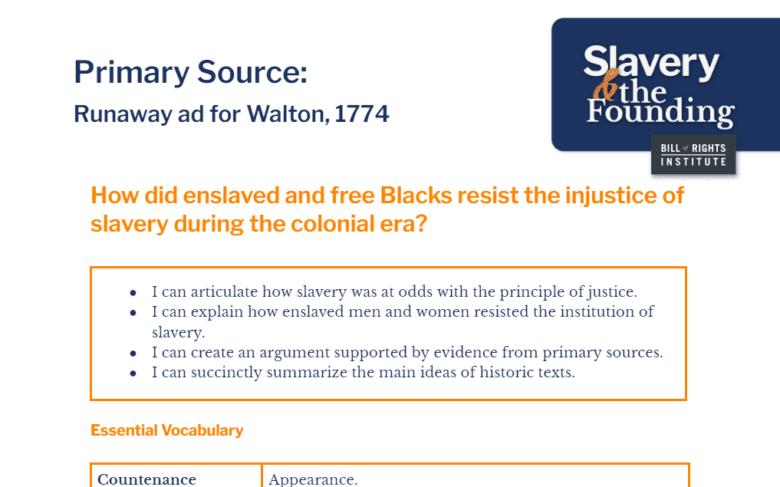Runaway advertisement for Walton, 1774
How did enslaved and free Blacks resist the injustice of slavery during the colonial era?
- I can articulate how slavery was at odds with the principle of justice.
- I can explain how enslaved men and women resisted the institution of slavery.
- I can create an argument supported by evidence from primary sources.
- I can succinctly summarize the main ideas of historic texts.
Essential Vocabulary
| Countenance | Appearance |
| Waitingman | Person who waits on customers in an inn or a place of lodging or in the home of a family |
| Endeavor | To try |
Building Context
When enslaved men, women, or children ran away to seek freedom from their unjust condition, slaveholders often published classified advertisements offering rewards for their return. Though the level of detail varies, these advertisements provided small insights into the lives of enslaved individuals. These featured descriptions of the person’s physical appearance, details surrounding their appearance, and a reward for their return. Running away to freedom was a dangerous choice. Many did not succeed and faced cruel physical punishments if they were caught.
Runaway ad for Walton, 1774
https://research.colonialwilliamsburg.org/CWDLImages/VA_GAZET/Images/PD/1774/0213hi.jpg
The Colonial Williamsburg Foundation, www.colonialwilliamsburg.com, Column 1
RUN away from the Subscriber, a Virginia born Negro Fellow named WALTON, 23 Years of Age, of a light Complexion, middle Size, has a pleasing Countenance … he carried with him four Shirts … two Suits of Clothes … Velvet Cap, Hat, and every Thing else suitable for a Waitingman. As he is a very artful and likely fellow, he may endeavor to pass for a free Man, and I am doubtful has got a Pass from a Negro of mine who can write a good Hand. This fellow has waiting on me for three Years past, and always rode with me, so that he has a general Acquaintance, but as he was raised in [Nansemond?], near the old Town, it is probably he is gone there, as his Friends live in that Neighbourhood. Whoever takes up the said Runaway, and brings him home, shall have 3 pounds reward, or 3 shillings if committed to Jail. All persons are forbid harboring or carrying the said Slave out of the Colony. PETERFIELD TRENT.
*As the said Fellow ran away without receiving any Abuse, the Taker up is desired to give him ten Lashes every ten Miles.
Comprehension and Analysis Questions
- Peterfield Trent wrote that Walton “may endeavor to pass for a free Man.” What might enable Walton to pass as free?
- Walton is said to carry a variety of clothing with him. What does that reveal about his role as a waitingman?
- How was Walton assisted by others in his attempt to secure his own freedom?
- What does the postscript reveal about Walton’s status as an enslaved person?
- Based on the evidence in this source, were the laws that governed Walton just? Explain.
- How did Walton resist the system of enslavement?
- Shrink the text: In one sentence, write what this source reveals about enslaved Blacks in colonial Virginia.



